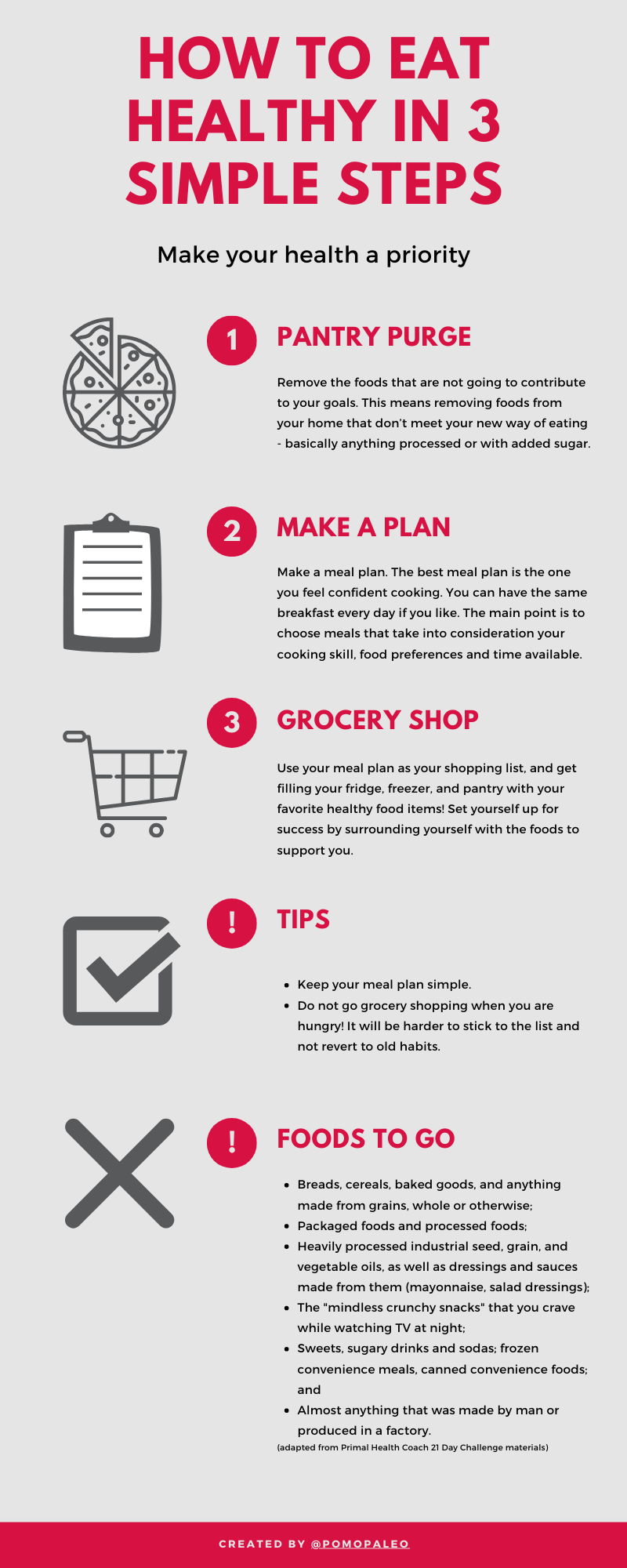How to Eat Healthy in 3 Simple Steps

I hear this every day: I don’t know what to eat; it’s so complicated; it’s expensive; etc.
All these things are true, especially if you are at the beginning of your journey to improve your health. There are simple steps you can take to transition to a healthy way of eating, but it doesn’t mean that it is easy.
In fact, many people report that they know what they need to do but struggle to do it. The disconnect between knowing and doing is having effective tools and changing the mindset to make lasting change. Often that involves external support (i.e. health coach or counsellor). It also helps to know if you are a person that can moderate or you need to abstain from certain foods or vices to be successful. But that is a blog post for another day.
This post only tackles the basic steps to transition to a healthier diet (when compared to a standard North American diet full of processed foods and refined sugars and grains).
Step 1: Pantry Purge
If you are planning on eating healthier, it is important to remove the foods that are not going to contribute to your goals. This means removing foods from your home that don’t meet your new way of eating. This might include:
Processed foods - these are foods that come in packages with more than five ingredients or ingredients that you don’t know what they are. These foods often contain ingredients that are not whole foods, such as maltodextrin [Maltodextrin is a starchy white powder made from any starchy food like rice, wheat, or potatoes]
Foods with added sugars - baked goods including cookies, pastries, crackers, pasta sauce, or condiments like ketchup. It is important to read the ingredients.
Industrial seed oils - this includes partially hydrogenated; refined high polyunsaturated vegetable/seed oils (canola, etc.); interesterified fats; buttery spreads and sprays; margarine; vegetable shortening; deep-fried foods. It does not include animal fats from pasture-raised animals or butter/ghee.
If it feels wasteful to throw out this food, donate unopened food to your local food bank or shelter. But the key to this exercise is to remove it from your house. This way you do not need to rely on willpower to avoid this food.
Step 2: Make a Plan
Now that you’ve eliminated foods that can derail your healthy eating plan, you need to restock your fridge and pantry. But before you head out to get groceries, you need a plan! If you have never made a meal plan before, the best advice I can give you is to “Keep It Simple!” Meal plans do not need to be fancy, filled with recipes you have never made before. The best meal plan is the one you feel confident cooking. You can have the same breakfast every day if you like. The main point is to choose meals that take into consideration your cooking skill, food preferences and time available. So make your meal plan of healthy foods, then make your grocery list. I’ve included a list of foods that you may want to include below.
Healthy foods to eat include:
Seasonal vegetables and berries - choose colourful, locally grown, in season, and organic when possible (see EWG list for foods that should always be organic)
Meat, fish, fowl, eggs - ideally from local farmers and ranchers that raise their animals humanely and on a biologically appropriate diet
Healthy fats - animals fats, avocados and avocado oil, butter, coconut oil, seeds, nuts, olives and olive oil
Step 3: Shop!
Before you head out, identify where you are going to go shopping - think of farmers’ markets, natural food stores or even your regular grocery store (in this case, shop the perimeter of the store - this is where you will find the fresh and perishable items).
Get your list from Step 2 and go shopping. [Tip - do not go grocery shopping when you are hungry! It will be harder to stick to the list and not revert to old habits.] Refer to your handy shopping list, and get filling your fridge, freezer, and pantry with your favourite healthy food items! Set yourself up for success by surrounding yourself with the foods to support you.
If you have a busy week, then set aside a day on your weekend to prep your meals. Prep work can range from chopping vegetables all the way to cooking and portioning out your meals. It depends on what will work best for you. Personally, if the week is busy, I prefer to spend half my Sunday cooking, as it makes weekdays much easier and weekday clean-up a breeze. But you will have to find what works best for you!
That's it!
And that’s it - the 3 simple steps to eating healthy. Not necessarily easy, but simple. If you need accountability or more assistance in making a plan to eat well and feel well, message me on Instagram @pomopaleo
*For more specific information on different types of diets that may be appropriate for you, please contact me.

